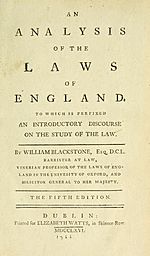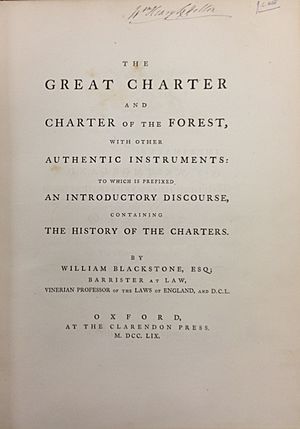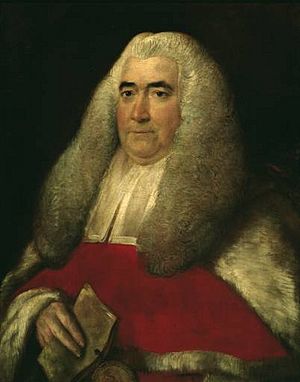William Blackstone facts for kids
Quick facts for kids
William Blackstone
|
|
|---|---|
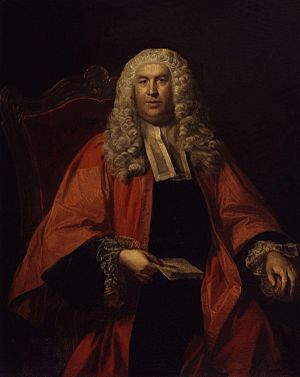
Portrait, c. 1723—1780
|
|
| Justice of the Common Pleas | |
| In office 25 June 1770 – 14 February 1780 |
|
| Preceded by | Edward Clive |
| Succeeded by | John Heath |
| Justice of the Court of King's Bench | |
| In office 16 February 1770 – 25 June 1770 |
|
| Preceded by | Joseph Yates |
| Succeeded by | William Ashurst |
| Member of Parliament for Westbury | |
| In office 1768–1770 |
|
| Preceded by | Chauncy Townsend |
| Succeeded by | Charles Dillon |
| Member of Parliament for Hindon | |
| In office 30 March 1761 – 1768 |
|
| Preceded by | James Calthorpe |
| Succeeded by | John St Leger Douglas |
| Personal details | |
| Born | 10 July 1723 London, England |
| Died | 14 February 1780 (aged 56) Wallingford, Berkshire, England |
| Resting place | St Peter's Church, Wallingford |
| Political party | Tory |
| Spouse |
Sarah Clitherow
(m. 1761) |
| Children | 8 |
| Alma mater | Pembroke College, Oxford Middle Temple |
| Signature | |
Sir William Blackstone (born July 10, 1723 – died February 14, 1780) was an English judge and politician. He is best known for writing the Commentaries on the Laws of England. This book explained English law in a clear way.
Blackstone grew up in London and went to Charterhouse School. Later, he studied at Pembroke College, Oxford. He became a lawyer in 1746. At first, his law career was slow. So, he focused on working for the university. He helped manage All Souls College, Oxford.
In 1753, Blackstone started giving lectures on English law. These were the first of their kind. His lectures were very popular. They led to his book An Analysis of the Laws of England in 1756.
In 1759, he became the first Vinerian Professor of English Law. This was a special teaching job at Oxford. He also became a Member of Parliament in 1761. In 1765, he published the first part of his famous Commentaries. This huge work made him well-known. He later became a judge in 1770. He served as a judge until he died in 1780.
Blackstone's Commentaries were very important. They helped people understand English law. They were used for legal education for many years. His work also greatly influenced the law in the United States. Many important American leaders studied his books.
Contents
Growing Up and School
William's father, Charles Blackstone, sold silk in London. His mother was Mary Bigg. They were a successful middle-class family. William was born on July 10, 1723. This was five months after his father passed away.
William went to Charterhouse School in 1730. He was nominated by a family relative. He did very well at school. By age 15, he was the head student. After his mother died in 1736, the family had less money. But William stayed at Charterhouse as a "poor scholar." He was helped by Robert Walpole.
Blackstone loved studying at Charterhouse. He especially liked Latin poetry. He also wrote his own poems. He won awards for his writing. His teachers thought he was a favorite student. In 1738, he went to Pembroke College, Oxford. He had a new scholarship for Charterhouse students.
Studying at Oxford
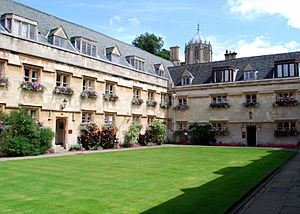
We don't have many records from Blackstone's time at Oxford. But we know he studied many subjects. These included Greek, science, logic, and poetry. He was very good at Greek, math, and poetry. His notes on William Shakespeare were even used in a later book. He owned many books, which was surprising since he wasn't rich.
In 1740, Blackstone started studying for a law degree. This was called a Bachelor of Civil Law. It was a seven-year course. In 1741, he joined the Middle Temple. This was a step toward becoming a barrister. At that time, there wasn't a formal law school. So, Blackstone read law books on his own.
While at Oxford, Blackstone also wrote poetry. His most famous poem was The Lawyer to his Muse. He also wrote about architecture. In 1747, he published The Pantheon: A Vision. This book of poems explored different religions. In 1743, he became a Fellow at All Souls College, Oxford. He became a barrister in 1746.
Blackstone then split his time between Oxford and London. He had offices in London but lived at All Souls College. His law career started slowly. He didn't have many connections. He was described as "unrecognized and unemployed." He worked as a lawyer for Oxford University. In 1749, he became a judge for Wallingford.
Helping the University
Blackstone also became a university manager. He helped finish the Codrington Library. He also made the college's accounting system much simpler. In 1750, he finished his first legal paper. It was about family ties to the college founder. He earned his Doctor of Civil Law degree in 1750. This allowed him to join the university's governing body.
In 1753, Blackstone decided to stop practicing law in London. He wanted to stay at Oxford. He planned to give lectures on common law. These were the first lectures of their kind in the world. He knew that a wealthy Oxford graduate, Charles Viner, planned to create a law professorship.
His lectures were very profitable. He earned a lot of money from them. The first lectures started in 1753. Even though Blackstone wasn't a great speaker, his lectures were popular. He used printed handouts and reading lists. These helped students learn. His lectures tried to make English law a logical system. This system later formed the basis of his Commentaries.
Blackstone became more involved in university life. He became the chief legal officer for the Chancellor's Court. He handled small debt cases. This job helped him meet many important people. In 1756, he wrote his last known poem, Friendship: An Ode.
In 1756, Blackstone published An Analysis of the Laws of England. This 200-page book explained his lecture series. It was a structured introduction to English law. The first 1,000 copies sold out quickly. More copies were printed and also sold out. This book was a big step forward for English law.
Becoming a Professor
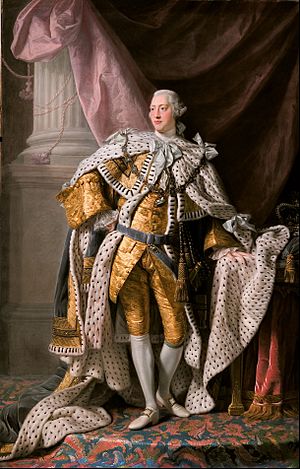
In 1758, a new teaching job was created. It was the Chair of English Law. On October 20, 1758, Blackstone became the first Vinerian Professor of English Law. He gave his first lecture on October 24. The text was published as A Discourse on the Study of the Law. It was very popular.
However, Blackstone was not popular within the university. Some people criticized him. He even had a period of poor health. This led to him leaving Oxford. But his influence outside the university grew. In 1759, Lord Bute, who taught Prince George, asked for Blackstone's lectures. Prince George became a loyal supporter.
In 1759, Blackstone published two more works. One was The Great Charter and the Charter of the Forest. This was an important historical study. It led to him joining the Society of Antiquaries of London. The other was A Treatise on the Law of Descents in Fee Simple. Parts of this book were later used in his Commentaries.
Life in London
Working as a Lawyer
With support from Prince George, Blackstone's law career grew. By 1760, he was a well-known figure. He had a steady flow of cases. In 1761, he married Sarah Clitherow. They had eight children, but two died young. The Blackstones lived on a large estate in Wallingford.
In 1761, Blackstone became a Tory Member of Parliament for Hindon. This did not stop his legal work. He was involved in important cases. These included a copyright case and a case on international law.
Blackstone also did a lot of work outside of court. He wrote legal advice for Oxford colleges. He also helped draft laws for Parliament. He wanted to become a judge. He applied several times but was not chosen.
His Famous Book: Commentaries on the Laws of England
In 1765, Blackstone decided to leave his teaching job. He wanted to focus on writing his new book. This book was the Commentaries on the Laws of England. The first volume came out in November 1765. It was a huge success. It earned him a lot of money. People praised it as "masterly." All copies sold out in six months.
The second and third volumes were published in 1766 and 1768. The fourth and final volume, on criminal law, came out in 1769. The Commentaries made Blackstone very wealthy. He moved to a nice house in London.
Blackstone's Commentaries were reprinted many times. They were used in England and Wales until the 1870s. A special version was even reprinted after the Second World War. The first American edition came out in 1772. Over 1,000 copies were sold in the American colonies before that.
Becoming a Judge
Even after his book's success, it was hard for Blackstone to become a judge. But in 1770, the government changed. On February 9, 1770, Blackstone became a Justice of the Common Pleas. He was also made a Serjeant-at-Law.
After only four days, he became a judge in the Court of King's Bench. This was because another judge, Joseph Yates, moved to the Common Pleas. Blackstone regularly served as a judge. He was known as a careful and respected judge. However, he was not considered a great trial judge.
Blackstone returned to the Common Pleas on June 25, 1770. He stayed there until his death. In this court, he handled civil cases. Many of his decisions were seen as forward-thinking. For example, his decision in Blaney v Hendricks helped set a rule about interest on loans.
Criticism
Not everyone agreed with Blackstone's ideas. The English legal thinker Jeremy Bentham was a strong critic. Some people thought Blackstone's descriptions of English law were not always accurate. They pointed out laws he left out or explained incorrectly.
Death
Blackstone had health problems for a long time. He suffered from gout. By late 1779, he also had a nervous disorder. He died on February 14, 1780, at age 56. He was buried in the family vault in St Peter's Church, Wallingford.
After his death, his wife Sarah received a royal pension. In 1780, All Souls College decided to build a statue of him. The life-sized statue shows Blackstone in his judge's robes. It cost a lot of money and is now in the Codrington Library.
Legacy
Blackstone's most important legacy is his Commentaries on the Laws of England. These books were in high demand for many years. They helped change English law. Before his books, people were not sure what the law was. The Commentaries helped make legal thinking clearer.
William Searle Holdsworth, another law professor, said that without the Commentaries, countries like the United States might not have adopted English law so widely.
The Commentaries had a huge impact in the United States. Early American leaders like Alexander Hamilton and Abraham Lincoln studied them. When the books were first printed in North America, 1,400 copies were ordered for Philadelphia alone. The US Supreme Court still refers to the Commentaries today.
Because law books were rare, Blackstone's books were often the only law school and library for American lawyers for almost a century. Blackstone had a plan for a law school at Oxford. When it was rejected, he put it in his Commentaries. This plan influenced how modern American law schools are set up.
In the 1920s, a statue of Blackstone was made for the English Bar Association. It was too tall for the building. So, it was given to the US. It stands in Washington, D.C., on Constitution Avenue. The town of Blackstone, Virginia, is also named after him.
Blackstone is also shown on the North Wall Frieze in the courtroom of the Supreme Court of the United States. This shows how important he was in legal history.
Blackstone's Ratio
One of Blackstone's most famous ideas is called "Blackstone's Ratio." It states that "it is better that ten guilty persons escape than that one innocent suffer."
This idea means that it's more important to protect innocent people. It's better for some guilty people to go free than for one innocent person to be punished. This idea has been around for a long time. But Blackstone's way of saying it made it famous.
Blackstone's Ratio is a key rule in English law. It is also used in courts and law schools in the US.
Works
- Elements of Architecture (1743)
- An Abridgement of Architecture (1743)
- The Pantheon: A Vision (1747)
- An Analysis of the Laws of England (1756)
- A Discourse on the Study of the Law (1758)
- The Great Charter and the Charter of the Forest, with other authentic Instruments (1759)
- A Treatise on the Law of Descents in Fee Simple (1759)
- Commentaries on the Laws of England (1765-1769)
- Reports in K.B. and C.P., from 1746 to 1779 (1781)
See also
 In Spanish: William Blackstone para niños
In Spanish: William Blackstone para niños
- US Constitution, influences


